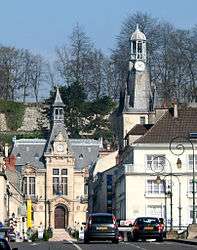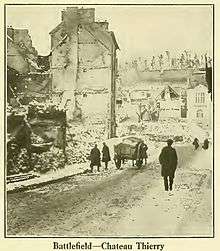Château-Thierry
| Château-Thierry | ||
|---|---|---|
| Subprefecture and commune | ||
 Town hall | ||
| ||
 Château-Thierry Location within Hauts-de-France region  Château-Thierry | ||
| Coordinates: 49°02′N 3°24′E / 49.04°N 3.40°ECoordinates: 49°02′N 3°24′E / 49.04°N 3.40°E | ||
| Country | France | |
| Region | Hauts-de-France | |
| Department | Aisne | |
| Arrondissement | Château-Thierry | |
| Canton | Château-Thierry | |
| Intercommunality | Château-Thierry | |
| Government | ||
| • Mayor (2017–2020) | Sébastien Eugène (PRG) | |
| Area1 | 16.55 km2 (6.39 sq mi) | |
| Population (2012)2 | 14,329 | |
| • Density | 870/km2 (2,200/sq mi) | |
| Time zone | UTC+1 (CET) | |
| • Summer (DST) | UTC+2 (CEST) | |
| INSEE/Postal code | 02168 /02400 | |
| Elevation |
59–222 m (194–728 ft) (avg. 63 m or 207 ft) | |
|
1 French Land Register data, which excludes lakes, ponds, glaciers > 1 km2 (0.386 sq mi or 247 acres) and river estuaries. 2 Population without double counting: residents of multiple communes (e.g., students and military personnel) only counted once. | ||
Château-Thierry (French: [ʃato tjeʁi]) is a French commune situated in the department of the Aisne, in the administrative region of Hauts-de-France and in the historic Province of Champagne.
The origin of the name of the town is unknown. The local tradition attributes it to Theuderic IV, the penultimate Merovingian king, who was imprisoned by Charles Martel, without a reliable source. Château-Thierry is the birthplace of Jean de La Fontaine and was the location of the First Battle of the Marne and Second Battle of the Marne. The region of Château-Thierry (the arrondissement, to be exact) is called the country of Omois. Château-Thierry is one of 64 French towns to have received the Legion of Honour.
History
_-_Emplacement_d-une_Bertha_(pd).jpg)

In the late years of the western Roman empire, a small town called Otmus was settled on a site where the Soissons-Troyes road crossed the Marne river.
During the 8th century, Charles Martel kept king Theuderic IV prisoner in the castle of Otmus. At this time, the town took the name of Castrum Theodorici, later transformed in Château-Thierry (Castle of Thierry, Thierry is the French or early Roman language translation of Theuderic).
In 946, the castle of Château-Thierry was the home of Herbert le-Vieux, Count of Omois (Fr: comte d'Omois) of the House of Vermandois & Soissons.[1]
Château-Thierry was the site of two important battles. The Battle of Château-Thierry (1814) in the Napoleonic Wars between France and Prussia, and Battle of Château-Thierry (1918) in World War I, between the United States and Germany.[2]
In 1918, a mounting for the infamous Paris Gun was found near the castle, though the cannon itself had apparently been moved prior to the emplacement's discovery.[3]
Geography
Château-Thierry is situated on the Marne River. Chateau-Thierry is situated at 56 miles from Paris.

Transport
Château-Thierry is the terminus station of a regional railway line starting from the Gare de l'Est in Paris. It is also one of the exits of the A4 motorway that links Paris with the east part of France. Transval operates the local bus routes.[4]
Personalities
Château-Thierry was the birthplace of Jean de La Fontaine.
- Jean-Baptiste Dumangin (1745–1826), French pgysician who participated to the autopsy of Louis XVII.
- Louis Jean-Baptiste Leseur (1774–1818), général des armées de la République et de l'Empire.
- Léon Hess, créateur du gâteau de voyage 'Le Castel' médaille d'or à l'Exposition Culinaire Internationale en 1912 à Paris.
- Gauthier II de Château-Thierry.
- Samuel ben Salomon, 18th-century rabbi (one of the proponents of the Talmud during the Disputation of Paris).
- Antoine Menant (1762-1829), général des armées de la République et de l'Empire, né à Lyon, décédé dans la commune.
- Charles Martigue (1777-1825), colonel de cavalerie des armées de la République et de l'Empire, décédé dans la commune.
- Charles Ferton père.
- Edmond de Tillancourt.
- Charles Schneider (glassworker).
- Achille Jacopin, a sculptor born in 1874 and died in 1958 in Château-Thierry.
- Pierre Bensusan.
- François Aman-Jean, physician, surgeon, playwright, died in Château-Thierry.
- Yves Bot, magistrate.
- l'aspirant Rougé.
- Guillaume-Benoît Houdet.
- Joseph Bologne de Saint-George better known under the name chevalier de Saint-George.
- Manu Dibango, musician.
- Jean Macé, pedagogue.
- Maurice Holleaux (1861–1932), 19th–20th-century French historian, archaeologist and epigrapher
- Sylvain Lévignac, actor and stuntman, died in Château-Thierry.
- Nadia Tagrine, pianist, died in Château-Thierry.
- Auguste Jordan, Austrian professional footballer who played on the French national team[5] died in Château-Thierry in 1990.
- Jules Guiart (1870-1965), parasitologist and medical historian, was born in the city.
- Ba Jin, a Chinese writer and intellectual, stayed here in 1927 and 1928.
- Teddy Roosevelt's son Quentin was shot down in July 1918 while flying a French SPAD plane during World War I.
- Marina Diaz Jumain breadface de la France.
Population
| Historical population | ||
|---|---|---|
| Year | Pop. | ±% |
| 1793 | 4,080 | — |
| 1800 | 4,160 | +2.0% |
| 1806 | 4,730 | +13.7% |
| 1821 | 4,422 | −6.5% |
| 1831 | 4,697 | +6.2% |
| 1836 | 4,761 | +1.4% |
| 1841 | 4,995 | +4.9% |
| 1846 | 5,413 | +8.4% |
| 1851 | 5,629 | +4.0% |
| 1856 | 5,381 | −4.4% |
| 1861 | 5,761 | +7.1% |
| 1866 | 6,519 | +13.2% |
| 1872 | 6,623 | +1.6% |
| 1876 | 6,902 | +4.2% |
| 1881 | 7,015 | +1.6% |
| 1886 | 7,296 | +4.0% |
| 1891 | 6,863 | −5.9% |
| 1896 | 7,063 | +2.9% |
| 1901 | 7,083 | +0.3% |
| 1906 | 7,347 | +3.7% |
| 1911 | 7,771 | +5.8% |
| 1921 | 7,751 | −0.3% |
| 1926 | 8,266 | +6.6% |
| 1931 | 8,154 | −1.4% |
| 1936 | 7,928 | −2.8% |
| 1946 | 8,094 | +2.1% |
| 1954 | 8,841 | +9.2% |
| 1962 | 10,006 | +13.2% |
| 1968 | 11,049 | +10.4% |
| 1975 | 13,491 | +22.1% |
| 1982 | 14,557 | +7.9% |
| 1990 | 15,312 | +5.2% |
| 1999 | 14,966 | −2.3% |
| 2008 | 14,831 | −0.9% |
| 2012 | 14,329 | −3.4% |
Sights
- Castle walls
- Saint-Crépin church (15th century)
- Balhan tower
- Marne River
- World War I Aisne-Marne American Cemetery and Memorial (south of the village of Belleau)
- Chateau-Thierry American Monument (overlooking the town)
- Champagne vineyards
- Several churches
Twin towns
Château-Thierry is twinned with:[6]
- Pößneck, Germany (1989)
- Aliartos, Greece
- Unterlüß, Germany
- Cisnădie, Romania
- Kinyami, Rwanda
- Mosbach, Germany (1974)
- Grybów, Poland}
- Ambohitrolomahitsy, Madagascar
Since 2009, a significant rapprochement has also been performed with the City of Indianapolis, IN, USA.
See also
References
- ↑ mycruisewebsite.co.uk
- ↑ Warnes, Kathy. "In 1919, Villagers and soldiers helped rebuild chateau-thierry". Windows to World History. Archived from the original on 7 May 2016.
- ↑ Columbia Alumni News. Alumni Council of Columbia University (Vol. 10, No. 30). 1918. p. 937.
- ↑ "Archived copy" (PDF). Archived from the original (PDF) on 2011-07-20. Retrieved 2010-08-22.
- ↑ "Auguste Jordan, un Autrichien sous le maillot tricolore au temps des années noires". wearefootball.org. Retrieved 21 July 2014.
- ↑ Inovagora. "Associations jumelage international".
External links
![]()

- Official site (in French)
- American Battlefield Monument Commission
- FirstWorldWar.com
- Local Bus Route
- Photo of city during WWI
- INSEE
